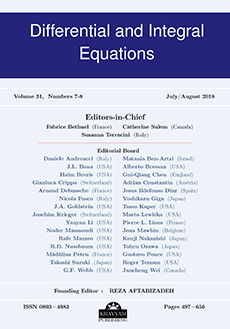Abstract
We determine necessary and sufficient conditions for a planar system of the form $$ \begin{align} \frac{dx}{dt} & = ax + by + x ( \alpha x + \beta y + Ax^{2} + Bxy + Cy^{2}) \\ \frac{dy}{dt} & = cx + dy + y ( \alpha x + \beta y + Ax^{2} + Bxy + Cy^{2}) \, , \end{align} $$ where $a, b, c, d, \alpha , \beta , A, B$ and $C$ are real constants, to possess a centre at the origin. The approach for computing the necessity of the conditions (i.e., for the calculation of the focal values) is somewhat unconventional, since it relies on the properties of an integrating factor, rather than a first integral, which expedites the procedure. The subclass consisting of those systems which possess a centre at the origin is studied further. In particular, first integrals are given, and phase portraits are drawn of all topologically inequivalent nonlinear members.
Citation
C. B. Collins. "Conditions for a centre in a simple class of cubic systems." Differential Integral Equations 10 (2) 333 - 356, 1997. https://doi.org/10.57262/die/1367526341
Information





